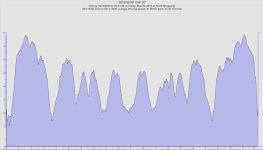Hi guys.
Been into this conversation a few times on the Garmin forums.

With a bicycle using a Garmin Edge GPS unit, you can buy a device that counts your rear wheel revs. The GPS unit can be set to calculate your wheel circumference or you can tell it what it is. It's just preference, but I always had mine set to "auto".
The GPS tracked your progress but your speed and distance was taken from your rear wheel. The unit re-calulated the rolling circumference periodically and adjusted the actual rolling circumference to correct the errors. At any time, you could look at one of the data fields and see your circumference. For argument's sake, let's say it was 2100mm.
When struggling up a hill, the circ would be less by a few mm's and on the flat or downhill a few mm's more. Also, as the tyre pressure varied with general leakage or through temp changes, the circ would vary again.
This never made much difference at any one time, but over (say) a 100mile ride, it could make a difference of a mile or two had you not set it to Auto. Some folk reckoned that it was more accurate to use it set to "manual", but it was a moot point and open to debate.
Of course you could not bother with the wheel system and use the GPS as a stand alone unit, but sometimes you go under heavy foliage or through a tunnel or in a city with tall buildings, and they can effect the accuracy of GPS. By using the wheel system, the speed and distance was far more accurate whether you used auto or manual. As I say, mine was always set to auto.
At one time, I cycled up to the A30 dual carriageway near Okehampton and headed west downhill for miles. Before I set off, I stopped at a marker post and reset my device, then off I went for 12Km counting the markers as I went past. At the 12Km point, my Garmin said 12Km, so it was spot on.

Now, when it comes to cars, the distance measuring system is rather unsophisticated. All it is is a detector of some sort on a drive shaft somewhere that is picked up electrically and makes pulses for each revolution. The distance readout is designed to be as accurate as they can make it, but if things conspire against the accuracy, the system cannot know.
In the old days, there was a bowden cable rotating away from the output shaft of the gearbox to the rear of the speedometer. Alter your final drive in the gearbox or diff and you needed to change the worm drive at the gearbox end to match so you could keep your speedo as near correct as possible.
These days, we have computers, so everything is perfect ........... isn't it?

Regards,
Mick.


